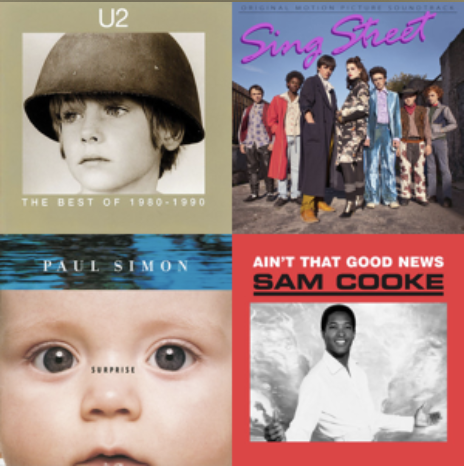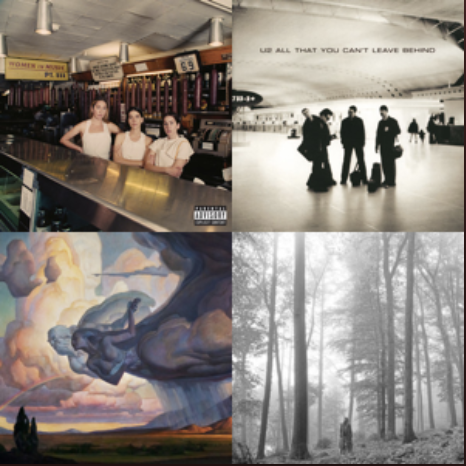
This is the second of a two-part interview with singer-songwriter Sandra McCracken. You can read the first part here.
Is there a certain atmosphere in which you write best? A time of day, room in the house; tea or coffee?
It happens sporadically; it’s somewhat unexpected when that actually occurs. If I feel inspired to write something, I have to take advantage of it as quickly as I can because they are fleeting moments, those clear moments of inspiration or a clear thought; journaling is really helpful. The music part can happen a lot more easily and regularly. If I sit down, I can chip away at something and I’ll come back to it and reevaluate and reshape it. But especially the lyrics and ideas – they happen when they happen. The challenge is to carve out enough space in my brain and schedule where I can be open and listening to that voice in my head.
I do like to record and sing vocals in the morning. Having a home studio is really conducive to that. When you’re paying for a studio by the hour, there’s often a lot of pressure. It’s such a different environment than having a home studio and going upstairs with a cup of coffee, still in your PJ’s, and recording something before you have time to over-think it. We did a lot of that on Red Balloon.
In “Storehouse”, I noticed a nod to Emmylou (the first waves of wisdom swing like a wrecking ball); and in “Big Blue Sky”, another to U2 (I still haven’t found what I’m looking for). How influential are these artists on your songwriting?
Those are both very influential artists/bands, and Wrecking Ball is in my top five. I listened to a lot of U2 during high school a little before that; they made a big impression – I love the approach lyrically. I don’t have to say that Achtung Baby and Joshua Tree are such culture-shaping albums and they certainly affected me in those ways, too. And I didn’t come into Wrecking Ball until a few years after it released. It’s just a quintessential piece of music from start to finish as a whole. Emmylou Harris and U2 are so different, but they’ve both made me who I am in a lot of ways.
Some of your songs reveal a beauty in melancholy and suffering, and at the same time, they’re comforting and empathetic. Are you conscious of this as you write?
It’s definitely a reflection of my personality and the way I see the world, the way I absorb things that happen around me. I’m conscious of trying to be as genuine and honest as I can with every lyric and everything that’s written. Sometimes I lean towards the ballads; it makes sense to go that way with the temperament I have. As long as I’m being honest, I don’t want to filter it too much as far as where it should go, but I certainly try to weave hope into even the darkest bits. As an artist, I think it’s appropriate to ask challenging questions or to open the door for people to ask their own challenging questions without feeling like you have to answer them or tie it all up neatly in a bow. I’m very conscious of the idea that there is a thread of hope that runs even in the darkest fabrics. I want to put that in there because in our season in life – where we are as a culture and in the world – I think cynicism can take over so easily. As a follower of Jesus, even, I try to weave that thread of hope into these songs and words. Hope is like a muscle we exercise; we choose to believe in these moments that these things will be made right. This is what we hope for. It’s like a new freedom to allow your heart to be broken because if you didn’t have hope, that would just be a bottomless pit. Those two things have a delicate balance, where we find ourselves living somewhere between the brokenness and the hope.
• You can hear songs from Red Balloon at the sampler on NoiseTrade.
‚Ä¢ To buy Red Balloon, visit Sandra McCracken’s web store, iTunes, or Amazon mp3.
• Sandra is currently on national tour with Derek Webb, Sara Groves, Charlie Peacock, and Brandon Heath for the Art Music Justice tour.
A song from Red Balloon – “The Tie That Binds” – is on the Art Music Justice tour compilation. How is this tour different from others you’ve been a part of?
It’s very different. We’ve just begun, actually. I’ve done a few collaborative tours with various artists and they’re always really enjoyable and interesting because each artist is so unique, one to the next. That’s a great thing for audiences to experience. The Art Music Justice tour is similar in that way to things I’ve done, but it’s different in the sense that it’s centered around using music, story, and what we have as artists to raise awareness for International Justice Mission and Food for the Hungry. IJM does incredible work with human trafficking by way of international law – going in, rescuing, and breaking down these rings of oppression of various kinds all over the world. It’s totally different than a normal tour for us. It’s a great feeling to put yourself aside and come together for a larger purpose, something that’s bigger than you just making another album. And the shows are mostly in churches, which is a different kind of venue, and the turnouts are bigger than one of my normal shows would be. I feel really honored to be a part of it.
What does justice mean to you?
It’s funny being a part of this tour. There are five of us and I think I’m more abstract – some of the spiritual meaning is a little more implicit in the way I write. I don’t really have protest songs like my husband does, so I didn’t know if I would fit into the tour. But as we started talking about how to pursue these shows, I started thinking about how justice (and the other themes) are written into and implicit in a lot of my relationship songs and in some of the presuppositions undergirding this material. Justice to me means the being made right of all things. There is a sense in which we can’t fix everything, but we work toward it and we try to relieve people that are in oppressive situations. I don’t have the resources to go into a brothel and make the situation right. But IJM does, and if I can play a few songs and they can go in by way of money generated from raising awareness on the tour, it’s one piece that I can contribute to this larger story. So to me, justice is all wrapped in that. I want to be the best writer and performer that I can be so that it gives some credibility toward people who can go further down that road and actually be the hands and feet of bringing justice and light to those dark places.
I downloaded the AMJ tour compilation from NoiseTrade, a revolutionary project. How has it benefited you as an artist?
Well, it’s been great – it’s paid the mortgage a month or two. And it’s been amazing to have people who like your music get the word out. They can give it to people who’ve never heard of you and help give exposure to someone like me. I don’t have a big budget behind me to get a song on the radio or anything like that. So a NoiseTrade campaign allows me to get more people to listen to my music. People who are interested can really latch onto that. They end up coming to a show or they can pay what they want, and there are so many other avenues in which they can come back and support you as an artist. It all really starts with that bonding: me giving away an album (or a batch of songs). It’s the least I can do to connect and find more people who might be interested in hearing it. It’s been a really great experience.

I read about the new album’s title on your blog, namely Albert Lamorisse’s film, The Red Balloon. What spoke to you in the film and how did it inspire the concept of your album?
I thought long and hard about this title. I saw that film when I was younger and they just did a re-make [Flight of the Red Balloon] that I need to see; I heard it’s really amazing. The original film [The Red Balloon] traces this story of a little boy and a red balloon and everything is in mostly black & white except the balloon. It’s in French, but I don’t know if there are any subtitles because there’s hardly any dialogue at all. There’s all this beautiful, playful interaction – the balloon follows him to school and gets him in trouble; stays with him and becomes his friend. At one point, there’s a group of boys that are picking on the one kid and they come after him to steal his balloon. The mean boys pop his balloon in a moment of tragedy and in the next scene, you see a bunch of balloons find the little boy and take him for a ride over the city. It’s a crazy, beautiful story. It’s very much like a children’s story, but it has these layers that I think are pivotal to the human experience: the friendship, the tragedy, and the ultimate transcendence, and how that traces our greatest story lines. The movie is so simple and doesn’t require any explanation in a sense, even though I just explained a lot of it.
I wanted a title that was whimsical and had an element of childhood because of some of my journey over the last year, but I also wanted something with other layers that you could peel back and find ways that it all fit in. “Red balloon” is a lyric in “Big Blue Sky” that I co-wrote with Katie Herzig and I wasn’t thinking about the film at the time, but then it came back around and seemed like a perfect fit, to nod to the film. And it’s just a striking image; it seems to capture the spirit of this record.
I’d like to see both of those films. Now, The Curator looks for what is rehumanizing in our culture – goodness, truth, and beauty; signs that point to “a world that ought to be.” What do you find to be rehumanizing in our culture?
That’s a great question that we should keep coming back to because it’s always going to be a different answer depending on your life stage, and it’s always worth asking. Something that’s been on the front of my mind the last few years with these transitions is caregiving – really caring for the people that you live with and that you love. People want to find their soul mate, get married, and have this perfect thing, but then it’s almost like a stepping stone because once you’re in that relationship, it’s so easy to look past it to your career and other things. But to really think about caregiving, day-to-day living, and caring for the people closest to you (in your life) is such an important work. It not only reflects our character, it builds our character, and it really has the power to change everything. Having a husband that loves me well and that affirms me has been so shaping and healing in my life. It sounds like a kind of simple and maybe a romantic idea, but it’s really not.
I heard someone (maybe Tim Keller) say that if you tell somebody something every day – even if it’s not true – they’re going to believe it. So if you keep saying, “You’re overweight”, they’re going to think that no matter what. They could be 5’5″ and weigh 90 lbs. and still feel like that. The thing is, the reverse is true as well. You should affirm someone unto the end by saying, “I know that you have this in you. I know that you can do these things. I know that you can reach your goals in life. I know that you have this.” Whether it’s a child, a friend, or a spouse, caring for and serving each other seems to be the primary catalyst for bringing and restoring good in my life and in the world around me right now. It’s a super-messy work. I see that in my family and with people I’m really close to when there’s unexpected and long-term sickness, or alcoholism passed down from one generation to the next. When you watch these things and you enter into them, it is never easy. It always feels like you want to throw your hands up because you have no idea what to even say in some of those moments. But that really feels like the fundamental inner-workings of who we are and who we’re becoming, and how we can make this place and this life more as it should be. For me, it’s relational and revolves around those primary relationships.
That is a great answer. Thanks so much for doing this interview, Sandra.
I’m really glad to do it – this was fun and it’s good to hear you.
For Further Listening
– Check out her discography which can be purchased on her web store or iTunes.
– Also on iTunes, you’ll find Sandra’s songs from the Caedmon’s Call albums In the Company of Angels, Back Home, and Overdressed, and the song “Ten Thousand Angels” (featuring Derek Webb) which aired on an episode of Grey’s Anatomy.
– Check out Sandra’s work on the Indelible Grace records.



